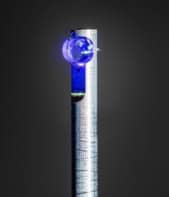
Can you obtain the dimensions of a darkened room by clapping your hands and listening to the echoes? Bats, dolphins and some other animals navigate using echoes and some blind humans have trained themselves to do this. Now engineers in Switzerland and the US have worked out a way to calculate the dimensions of a room using a single loudspeaker and four arbitrarily placed microphones. They believe this could find applications in building design, audio forensics and much more.
In his famous 1966 paper entitled “Can one hear the shape of a drum?” the Polish mathematician Mark Kac asked whether or not a listener could uniquely identify the shape of a vibrating membrane after hearing its resonant frequencies. In 1992 the American mathematician Carolyn Gordon and colleagues showed that the answer is no. In theory, however, it should be possible to hear the shape of a room by producing a sound and measuring the time taken for the echoes to arrive at particular points. But doing this in practice is not easy.
Several methods to calculate a room’s geometry from its echoes have all had significant limitations. Some have worked only in 2D. Others need an array of microphones that are placed sufficiently close together that the sound only has time to make one round trip to the walls and back, which may not always be possible if the sound source is close to one of the walls.
Works with flat walls
Now researchers at the École Polytechnique Fédérale de Lausanne (EPFL) in Switzerland and Harvard University in the US have developed an algorithm that uses sound to work out the dimensions of any room with flat, protrusion-free walls. The system uses a single loudspeaker to create sound and four microphones placed anywhere in the room to capture the echoes.
The algorithm that was created by the team only deals with first-order echoes, which means they exclude echoes of echoes. Lead researcher Ivan Dokmanić explains that this makes the system more practicable, as higher-order echoes can be too faint to isolate from background noise. However, isolating first-order echoes is also a challenge because it is not possible to say from a single recorded sound how many walls it has bounced off before reaching the microphone. The algorithm begins, therefore, by looking at the sounds recorded by the four microphones together and working out which sounds come from the same wall. The researchers propose two mathematical methods for doing this. “Once we know which echoes have to be grouped together,” says Dokmanić, “then from there we can compute which signals are first order and which are second order.” Using the arrival time at each microphone of all the first-order echoes, the researchers calculate the size and shape of the room.
They tested their algorithm by calculating the dimensions of a lecture theatre at EPFL and comparing the results of their echo calculations with the actual values. They found the two were remarkably close: the 7.08 m distance between two walls, for example, was calculated as 7.01 m – a discrepancy of less than 1%. They decided to find out how well their algorithm would perform when the requirement that the walls be flat and protrusion-free was not satisfied by placing their set-up in the portal of Lausanne Cathedral, which has a domed ceiling and numerous protrusions such as pillars and large statues. Even here, their system calculated the distances between flat surfaces accurately.
Concert halls and forensics
The researchers foresee a variety of possible applications for their technology. Most obviously, it could be used by architects and sound engineers designing a building in which echoes are important, such as a concert hall, to ensure that the room has the desired acoustics. Another potential application that the researchers are currently investigating, says Dokmanić, is to measure the echoes that a sound produces within a building where the geometry is known and to use the information to work out where in that building the sound was emitted. This could be used in forensics, for example.
Fabio Antonacci of the Image and Sound Processing group at Milan Polytechnic, an expert on this subject who was not involved in the present research, says, “One of the trickiest technical points in the estimation of room geometry is the assignment of echoes to the wall that generated them. Dokmanić [and colleagues] propose two elegant and innovative techniques for this purpose. This is the core of the article and, I believe, the most promising feature for follow-up.”
The research is published in Proceedings of the National Academy of Sciences.



